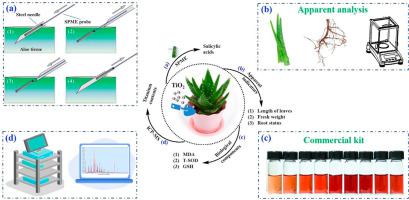当前位置:
X-MOL 学术
›
Anal. Chim. Acta
›
论文详情
Our official English website, www.x-mol.net, welcomes your
feedback! (Note: you will need to create a separate account there.)
In vivo tracing of endogenous salicylic acids as the biomarkers for evaluating the toxicity of nano-TiO2 to plants
Analytica Chimica Acta ( IF 5.7 ) Pub Date : 2021-02-01 , DOI: 10.1016/j.aca.2020.10.063 Xu’an Fang , Yuan-Jun Tong , Nan Li , Lu-Dan Yu , Gangfeng Ouyang , Fang Zhu
Analytica Chimica Acta ( IF 5.7 ) Pub Date : 2021-02-01 , DOI: 10.1016/j.aca.2020.10.063 Xu’an Fang , Yuan-Jun Tong , Nan Li , Lu-Dan Yu , Gangfeng Ouyang , Fang Zhu

|
Currently, nano-titanium dioxide (nTiO2) is considered an emerging environmental contaminant. Bottlenecked by the traditional destructive and lethal sampling methods, nTiO2's effect in living plants is poorly investigated. Here, in vivo tracing of endogenous salicylic acids at regular intervals was performed by using solid phase microextraction (SPME) technique for evaluating the effects of nTiO2 on plants. By planting aloe in soil containing varying amounts of nTiO2, the titanium (Ti) element accumulated in the leaves to concentrations and then reached the maximum of 1.1 ± 0.4 μg/g after nTiO2 exceeding 0.1 g/kg. The levels of salicylic acid (SA) and acetylsalicylic acid (ASA) were up-regulated upon the exposure to nTiO2, while were positively correlated to the contents of Ti. Moreover, the increased malondialdehyde, decreased total superoxide dismutase and fluctuated glutathione along with the addition of nTiO2 demonstrated the oxidative stress caused by nTiO2. Meanwhile, apparent growth indicators including leaf elongation, plant fresh weight and root development were influenced, which further confirmed the toxicity of nTiO2 imparted on aloe. This study presents the possibility of using salicylic acids as biomarkers for revealing the toxicity of nTiO2 on plants in addition to the other biomarkers and biomass data, and the in vivo SPME technique is powerful for their monitoring.
中文翻译:

内源性水杨酸的体内示踪作为评估纳米二氧化钛对植物毒性的生物标志物
目前,纳米二氧化钛 (nTiO2) 被认为是一种新兴的环境污染物。由于传统的破坏性和致命采样方法的瓶颈,nTiO2 在活植物中的影响很少被研究。在这里,通过使用固相微萃取 (SPME) 技术评估 nTiO2 对植物的影响,定期进行内源性水杨酸的体内追踪。通过在含有不同量 nTiO2 的土壤中种植芦荟,钛 (Ti) 元素在叶子中积累到一定浓度,然后在 nTiO2 超过 0.1 g/kg 后达到最大值 1.1 ± 0.4 μg/g。接触nTiO2后水杨酸(SA)和乙酰水杨酸(ASA)水平上调,而与Ti含量呈正相关。此外,增加的丙二醛,降低总超氧化物歧化酶和波动的谷胱甘肽以及添加 nTiO2 证明了 nTiO2 引起的氧化应激。同时,叶片伸长率、植株鲜重和根系发育等表观生长指标受到影响,进一步证实了nTiO2对芦荟的毒性。这项研究提出了使用水杨酸作为生物标志物的可能性,除了其他生物标志物和生物量数据外,还可以揭示 nTiO2 对植物的毒性,并且体内 SPME 技术对于它们的监测非常有效。这进一步证实了 nTiO2 对芦荟的毒性。这项研究提出了使用水杨酸作为生物标志物的可能性,除了其他生物标志物和生物量数据外,还可以揭示 nTiO2 对植物的毒性,并且体内 SPME 技术对于它们的监测非常有效。这进一步证实了 nTiO2 对芦荟的毒性。这项研究提出了使用水杨酸作为生物标志物的可能性,除了其他生物标志物和生物量数据外,还可以揭示 nTiO2 对植物的毒性,并且体内 SPME 技术对于它们的监测非常有效。
更新日期:2021-02-01
中文翻译:

内源性水杨酸的体内示踪作为评估纳米二氧化钛对植物毒性的生物标志物
目前,纳米二氧化钛 (nTiO2) 被认为是一种新兴的环境污染物。由于传统的破坏性和致命采样方法的瓶颈,nTiO2 在活植物中的影响很少被研究。在这里,通过使用固相微萃取 (SPME) 技术评估 nTiO2 对植物的影响,定期进行内源性水杨酸的体内追踪。通过在含有不同量 nTiO2 的土壤中种植芦荟,钛 (Ti) 元素在叶子中积累到一定浓度,然后在 nTiO2 超过 0.1 g/kg 后达到最大值 1.1 ± 0.4 μg/g。接触nTiO2后水杨酸(SA)和乙酰水杨酸(ASA)水平上调,而与Ti含量呈正相关。此外,增加的丙二醛,降低总超氧化物歧化酶和波动的谷胱甘肽以及添加 nTiO2 证明了 nTiO2 引起的氧化应激。同时,叶片伸长率、植株鲜重和根系发育等表观生长指标受到影响,进一步证实了nTiO2对芦荟的毒性。这项研究提出了使用水杨酸作为生物标志物的可能性,除了其他生物标志物和生物量数据外,还可以揭示 nTiO2 对植物的毒性,并且体内 SPME 技术对于它们的监测非常有效。这进一步证实了 nTiO2 对芦荟的毒性。这项研究提出了使用水杨酸作为生物标志物的可能性,除了其他生物标志物和生物量数据外,还可以揭示 nTiO2 对植物的毒性,并且体内 SPME 技术对于它们的监测非常有效。这进一步证实了 nTiO2 对芦荟的毒性。这项研究提出了使用水杨酸作为生物标志物的可能性,除了其他生物标志物和生物量数据外,还可以揭示 nTiO2 对植物的毒性,并且体内 SPME 技术对于它们的监测非常有效。











































 京公网安备 11010802027423号
京公网安备 11010802027423号